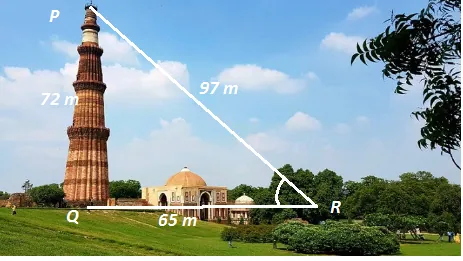Case Study Question Class 10
Government council of a local public development authority of Dehradun to build an adventurous playground on the top of a hill, which will have adequate space for parking.

After survey, it was decided to build rectangular playground, with a semi-circular area allotted for parking at one end of the playground. The length and breadth of the rectangular playground are 14 units and 7 units, respectively. There are two quadrants of radius 2 units on one side for special seats. [CBSE 2023]
Based on the above information, answer the following question :
(i) What is the total perimeter of the parking area ? 1
(ii) (a) What is the total area of parking and the two quadrants ? 2
OR
(b) What is the ratio of area of playground to the area of parking area ? 2
(iii) Find the cost of fencing the playground and parking area at the rate of Rs 2 per units. 1
Solution :
(i)Radius of the parking area (r)= 7/2
Perimeter of the parking area = Circumference of the semicircle of parking area + Diameter of semicircular parking area
= π r + 2 r
![]()
![]()
![]() units
units
(ii) (a) Radius of semicircle = 7/2 units
Radius of quadrant = 2 units
Area of semicircle ![]()
![]()
![]()
![]()
![]() units
units
Area of quadrant ![]()
![]()
![]()
Area of parking field and two quadrant = Area of Parking + 2(Area of quadrant)
= 19.25 + 2(3.14)
= 19.25 + 6.28
= 25.53 units
OR
(b) Length of playground = 14 units
Breadth of playground = 7 units
The ratio of area of playground to the area of parking area
![]()
![]() [From (ii) (a) ]
[From (ii) (a) ]
![]()
![]()
(iii) Perimeter of the playground and parking area = 2(Length of playground) + Breadth of playground + Circumference of Semicircle
= 2(14) + 7 + π r
![]()
![]() units
units
Cost of fencing per unit = Rs 2
Cost of fencing = 2 × Perimeter of the playground and parking area
= 2(46) = Rs 92
Case Study 2
Two schools ‘P’ and ‘Q’ decided to award prizes to their students for two games of Hockey Rs x per student and Cricket Rs y per student. School ‘P’ decided to award a total of Rs 9,500 for the two games to 5 and 4 students respectively; while school ‘Q’ decided to award Rs 7,370 for the two games 4 and 3 students respectively.

Based on the given information, answer the following questions:
(i) Represent the following information algebraically (in terms of x and y). 1
(ii) (a) What is the prize amount for hockey ? 2
OR
(b) Prize amount on which game is more and by how much ? 2
(iii) What will be the total prize amount if there are 2 students each from two games ? 1 [CBSE 2023]
Solution :
Given,
Award prizes to their students for games of Hockey = Rs x per student
Award prizes to their students for games of Cricket = Rs y per student
For School ‘P’
5 x + 4 y = 9,500 ……….(i)
For school ‘Q’
4 x + 3y = 7,370 ……….(ii)
(ii) (a) From question (i)
Solving equation (i) and (ii)
5 x + 4 y = 9,500 ……….(i)
4 x + 3y = 7,370 ……….(ii)
Multiplying 3 in (i) and 4 in (ii) and substracting (i) to (ii)
3(5 x + 4 y) – 4(4 x + 3 y) = 3×9500 – 4×7370
⇒ 15 x + 12 y – 16 x – 12 y = 28500 – 29480
⇒ – x = – 980
⇒ x = 980
Putting this value in eq (i)
5 x + 4 y = 9,500
⇒ 5(980) + 4y = 9500
⇒ 4900 + 4 y = 9500
⇒ 4 y = 9500 – 4900
⇒ 4 y = 4600
⇒ y = 1150
The prize amount for hockey = Rs 980
OR
(ii)(b) The prize amount for hockey = Rs 980
and The prize amount for Cricket = Rs 1150
The prize of Cricket is more than the Hockey
Tmore amount of Cricket = 1150 – 980
= Rs 170
(iii) Total prize of 2 student of Hockey and 2 student of Cricket
= 2 x + 2y
= 2(980) + 2(1150)
= 1960 + 2300
= Rs 4,260
Case Study 3
Jagdish has a field which is in the shape of right angle triangle ΔAQC. He want to leave a space in the form of square PQRS inside the field of growing wheat and remaining for growing vegetables (as shown in the figure). In the field, there is a pole marked as O.

Based on the above information, answer the following questions :
(i) Taking O as origin, coordinate of P are (-200, 0) and of Q are (200, 0). PQRS being a square, what are the coordinates of R and S ? 1
(ii) (a) What is the area of square PQRS ? 2
OR
(ii) (b) What is the length of diagonal PR in square PQRS ? 2
(iii) If S divides CA in the ratio K:1, what is the value of K, where point A is (200, 800) ? 1
[CBSE 2023]
Solution:
(i) Taking O as origin, the cordinate of P(-200, 0) and Q(200, 0). PQRS is a square

From the graph
Coordinate of R is (200, 400) and the coordinate of S is (-200, 400)
(ii)(a) Side of a square PQRS = PQ = PO + OQ
⇒ PQ = 200 + 200 = 400 units
Area of square(PQRS) = (Side)²
= (400)² = 160000 sq units
OR
(ii)(b) Length of the diagonal of square(PR) = √2×side
= √2×400 = 400√2 units
(iii) Given point A(200, 800) and Point S is (-200, 400)
Here Point C is (-600, 0)
For calculation of K we have to use Section formula
Since, S divides CA in K : 1 Then
![]()
Then,
![]()
Using ![]()
![]()
$\Rightarrow 400(K + 1) = 800
⇒ 400 K + 400 = 800
⇒ 400 K = 400
⇒ K = 1
Therefor the value of K is 1.

